Content Distribution
From Hong Kong to the NBA, how China is losing the media war
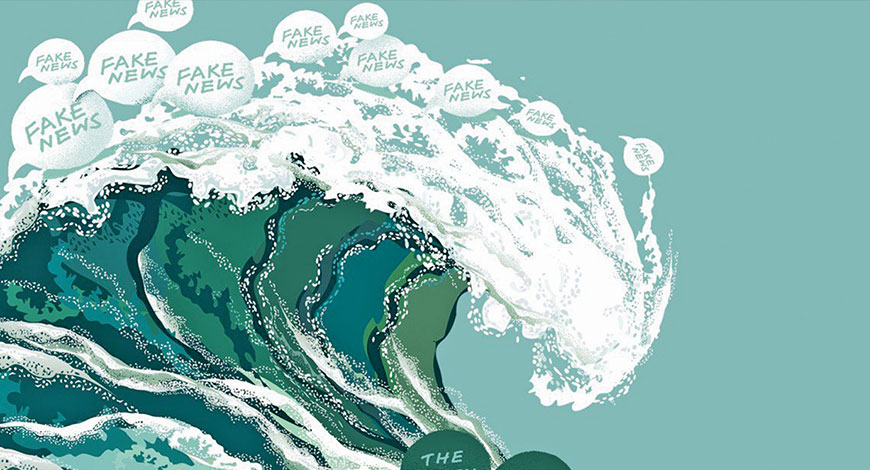
All through the sweltering summer recess, Michael, 23, and Stella, 19, have gone together to protest on the streets of Hong Kong. Occupying the city’s main thoroughfares, setting up barricades, and choking on poisonous tear gas, have become their “default dating activities on weekends,” said Michael.
But as the citywide protests, sparked by a piece of legislation that would have allowed Hong Kong residents to be extradited to the mainland, entered their fifth month and morphed into a wider call for democratic freedoms, they realized that street battles alone would not be enough to sustain the movement’s momentum.
“We all know we are here for a long game, and the protest cannot go on without broad public support,” said Michael. “We have to win people’s hearts before we can win the fight.”
Wary that the government – with its vast resources and its access to global and local media channels – was able to drive the news cycle with its own interpretation of events, Michael and Stella, as part of a larger group of protesters, began to organize the Citizens’ Press Conference to speak for themselves.
“We built this platform to amplify the voices that are missing from mainstream narratives, so that the media can tell the other side of the story,” said Stella.
This idea was first proposed on LIHKG, a Reddit-like online forum in Hong Kong that has been widely used by protesters. Within days, the group amassed over a hundred enthusiastic volunteers, some with experience in media and public relations, to get the ball rolling. Depending on their expertise, volunteers were divided into teams, covering everything from media liaison to logistics to writing and translation.
On its debut on August 6, 2019 dozens of local and international journalists packed into a tiny temporary press room in a downtown commercial building. The spokespeople, wearing face masks and helmets to conceal their identities, delivered speeches and answered questions eloquently in Chinese and English. Sign language interpreters worked simultaneously.
Using the same technologies and philosophies that have propelled the fluid, self-organizing tactics of protesters on the streets, a largely amateur group of Hong Kong’s citizens has taken on the media machine of the Beijing-backed government. As protests rage on the street, backroom volunteers have amplified and broadcast their demands, exposed police aggression, and helped to give a human face to a pro-democracy movement that has vacillated between peaceful protest and violent resistance. Their campaign has seen them continuously wrest control of the narrative, leaving Carrie Lam’s government looking isolated and out of touch.
The Citizens’ Press Conference has won over hearts and minds, said Bruce Lui, a longtime reporter and senior lecturer in journalism at Hong Kong Baptist University. “Most importantly, it presents to the public what the authority lacks – authenticity and sincerity. People here are fed up with canned speeches and scripted responses.”
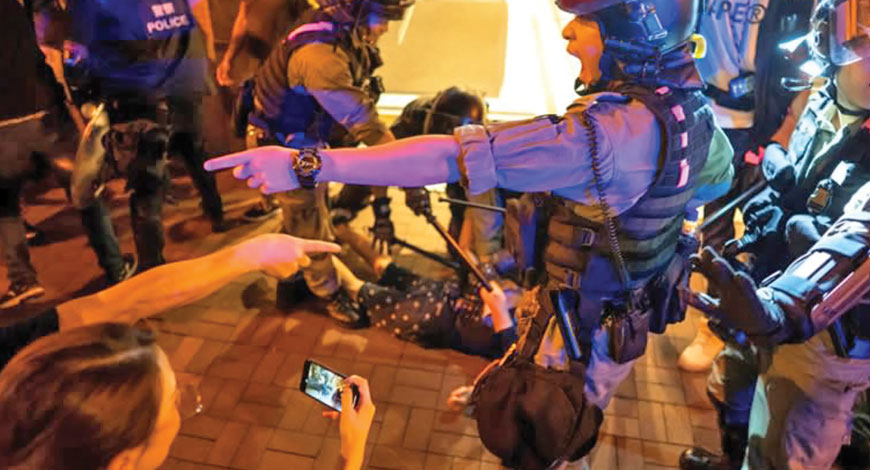
Tired tactics
As Hong Kong’s anti-extradition bill protests gathered pace from June through August, attracting the attention of the global media, the Hong Kong government returned to its old playbook. Since early August, the Hong Kong police force has typically held to a daily scheduled 4 pm press briefing.
Uniformed spokespeople, sitting in front of the official backdrop, have repeated the same words from previous government statements and consciously dodged critical questions from journalists. The press conferences, and the government’s overall messaging, have focused almost entirely on the amount of damage and disruption caused by the protests.
“The government hopes that by doing [this], ordinary citizens who are tired of the unrest would turn against the protesters gradually,” said Lui, adding that the same tactic was also used 5 years ago during the Umbrella Movement, when protesters staged a 79-day mass sit-in to call for universal suffrage. That movement eventually died out with no concessions from Beijing.
This time, though, there is no sign that the tactic is working. The protests still enjoy overwhelming support among Hong Kongers, in spite of the escalating violence from both sides. The major demands of protesters, including an independent inquiry into police behavior and universal suffrage, are endorsed by over 80 percent of the people, a recent survey by the Chinese University of Hong Kong shows. More than 70 percent believe that the government and the police force itself are most responsible for the violence.
There have been moments when protesters’ actions threatened to turn the media, and society at large, against them. In August, sit-ins paralyzed the city’s airport, causing major disruption to travel; at one stage, a reporter from Chinese state media was publicly beaten by demonstrators who accused him of spying. In September and October, protesters vandalized railway stations, accusing the mass
transit operator MTR of cooperating with the police and helping them to cover up brutality.
Still, protesters mostly managed to keep the public on their side by offering apologies and explanations. “We have to admit that we are not perfect,” said Michael from the Citizens’ Press Conference. “We make mistakes sometimes, but we are willing to listen and correct ourselves.”
In their press conferences, they have also tried to explain their more radical actions, such as vandalizing shops that are affiliated with the Chinese Communist Party and those allegedly linked to triad attacks on protesters. “Apart from specific targets, most private properties have been spared from the protest. We want the public to know that protesters never act indiscriminately,” said Michael.
This responsiveness stood in stark contrast to the government and police, who stuck to their script and refused to take any responsibility for the escalating violence.
While the administration pushed out its talking points, and while Lam herself appeared distant and unresponsive, Michael and Stella’s virtual press office was in overdrive.
Over the past 2 months, Stella, Michael, and their colleagues have organized 20 media conferences with various themes, from refuting official claims to criticizing the authorities’ handling of the protest. Despite the professionally conducted events – bilingual press releases, infographics, and original surveys were prepared to make a case for protesters’ demands and alleged police brutality – the team consists mainly of amateurs.
They are not alone. Some other groups have used the anonymous messaging app Telegram to disseminate press releases, invite media to protest events, and connect journalists with protesters who are willing to take interviews. In some of the groups, there are even on-duty administrators taking shifts to handle inquiries from journalists round the clock.
Even away from the front lines of the protest, this has been a risky operation. Michael and Stella asked to remain anonymous to protect against reprisals or arrest, at a time when assaults on pro-democracy figures are becoming more frequent. Civil Human Rights Front leader Jimmy Sham, who organized many of the city’s largest peaceful protests, was attacked recently by unidentified men with hammers. Other pro-democracy candidates running for the district council election in November have also faced various forms of assaults.
“You never know what would happen. It might put our jobs, and even our personal safety at risk,” said Stella.
At the end of each press conference, the couple is always the last to leave after everyone gets changed out of their helmets and masks. They take a circuitous route back home to avoid pursuit. For extra security, the speakers and even the venues are different every time.
“If the government finds out who we are, we will all be charged with inciting unlawful assembly immediately,” said Michael – his tone surprisingly nonchalant, given that a number of non-front-line protesters, including administrators of protest-related Telegram groups, have been arrested on similar charges.
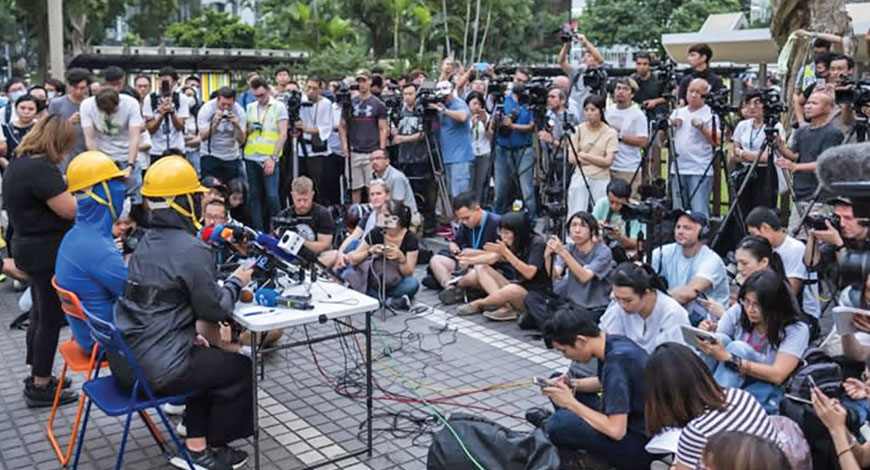
Global battle lines
As they fought for public support at home, the protest groups also reached out internationally. Since June, a group formed by anonymous activists, Freedom Hong Kong, has taken out adverts in news media around the world, seeking to portray the extradition bill and the wider erosion of rights in Hong Kong as an act of aggression – not just against the city, but on freedom and democracy worldwide.
In the latest campaign, activists raised HKD 9.2 million (USD 1.2 million) through crowdfunding platform GoGetFunding, placing ads in news media across 16 countries on the 70th anniversary of the People’s Republic of China. Over 22,500 people contributed to the fund.
The advertisement, in English titled Hong Kong’s today; The world’s tomorrow, aims to warn readers of the threats posed by the Chinese Communist regime to freedoms around the globe, according to the organizer. “Multinational corporations bend their knees to Beijing’s intimidation and intervention. China is waving its claws at the free world to step up its oppression, the advertisement reads.
Mimi Lee, a Hong Kong emigrant in Canada who helped liaise with local newspapers for the ad placements, said the campaign was well-received in the country. As awareness of the protest in Hong Kong increased in the country, some papers even offered advertisement space for free. “They want to let Hong Kongers know that they are not alone in their fight for freedom,” she said.
The government tried to use the same channels to sway opinion around the world, splashing HKD 7.4 million in September on full-page adverts in overseas newspapers, including The Australian Financial Review, The Financial Times, The Washington Post, The New York Times, the Frankfurter Allgemeine Zeitung, and The Nikkei. The Financial Times and The Nikkei are owned by the Nikkei Asian Review’s parent company, Nikkei.
The adverts attempted to reassure international investors that Hong Kong was still open for business, saying that the government was determined to achieve a peaceful, rational, and reasonable resolution, and that the territory remained a safe, open, welcoming, and cosmopolitan society and an internationally connected, vibrant and dynamic economy.
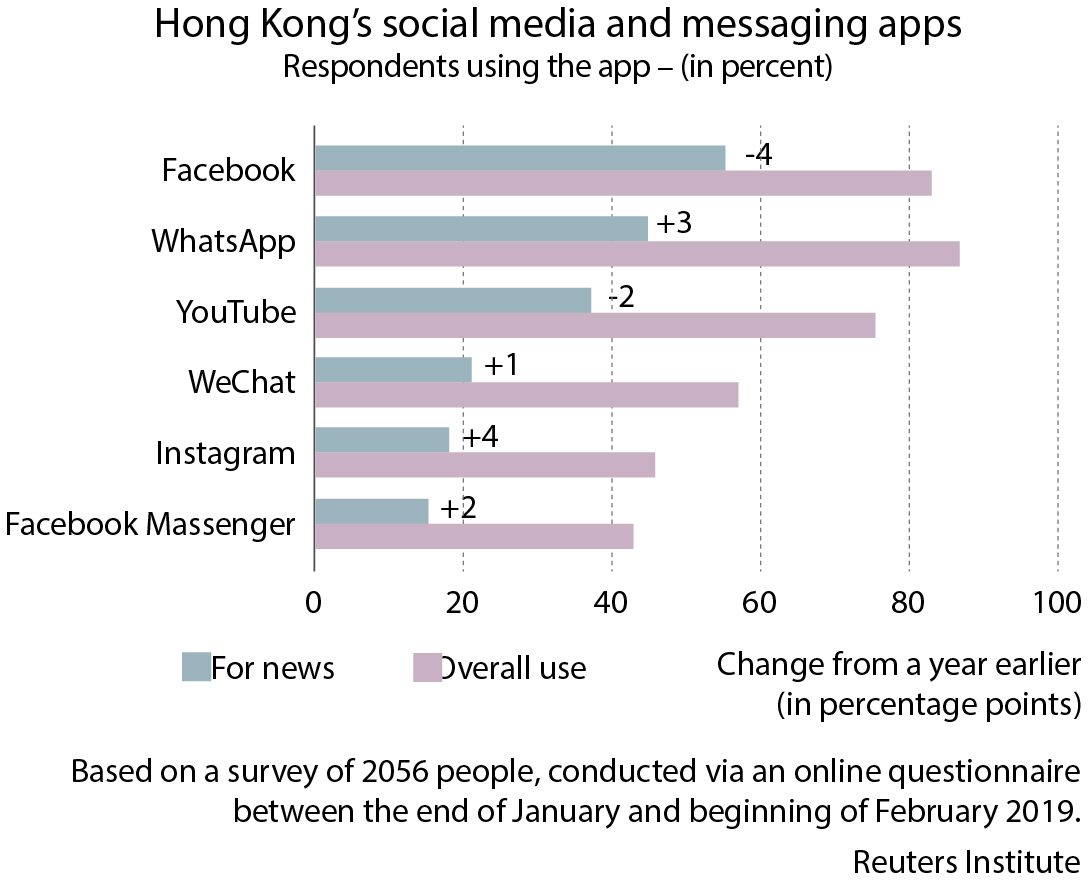
The campaign, though, did not swing opinion in their favor; internationally, the Hong Kong government’s brand had become toxic. In September, Reuters reported that at least eight global public relations companies declined the government’s invitation to help rebuild its battered reputation. A leaked tender document for the project shows that its objective was to address negative perceptions and maintain confidence in Hong Kong among foreign business communities and elites.
A public relations executive told Nikkei that his company rejected the bid without a second thought. “It is impossible to devise an effective campaign when the crisis is still deepening in Hong Kong every day. Taking up a job that is bound to fail would only hurt our reputation,” he said.
The international campaign was doomed from the outset, according to Kaman Lee, a PR industry veteran and an associate professor in communications at the Chinese University of Hong Kong.
“This is certainly beyond the capacity of what PR can do. If the government does not deal with the crux of the problem, we cannot simply paint a glossy picture when it is obviously not the case,” Lee said. “The administration seems to forget that they are targeting … intelligent and highly skeptical audiences who have free access to information. How are you going to convince them?”
War of attrition
The virtual press rooms are not just standing against the Hong Kong administration’s media apparatus, but against the vast online resources of the Chinese Communist Party. Pro-Beijing trolls – the so-called 50-cent army, named for the price they are supposedly paid for each post – as well as state-backed media and botnets have been employed to pump out huge quantities of disinformation and misinformation, designed to undermine the protesters as rioters and stooges of foreign powers.
In some of the online posts, protesters were compared to cockroaches, while front-line reporters were accused of cooperating with protesters to make police look bad.
Some social media pages market themselves as self-organized news platforms that report the truth not told by traditional media. While state media cited the presence of non-Chinese protesters in local marches as evidence of foreign forces at work, going as far as dubbing them terrorists, some pro-Beijing users have taken this even further, misidentifying white journalists, protesters, or passersby as enemy operatives, and amplifying the narrative that the demonstrations are the result of interference by the CIA or other Western aggressors.
To reach the audience beyond the Great Firewall, the state media has paid the likes of Twitter, YouTube, and Facebook to promote its editorial content.
“The Chinese Communist Party’s strategy seems to be aimed at convincing the international community that the Hong Kong protesters, who were lauded for their civic-mindedness and peaceful mass rallies at the start of the anti-extradition bill protests, have gone beyond the pale in their demonstrations,” said Larry Ong, a senior analyst at SinoInsider, a US-based China political risk consultancy.
“With more and more bad press about violence in Hong Kong, Beijing bets … that international opinion will slowly shift away from being sympathetic to the protesters to being in favor of the government’s suppression, weakening the case for those who continue to voice their support for the Hong Kong people,” he added.
On the mainland, online discussion of the mass protests was initially muted, due to limited news coverage. That changed after July 21, when a group of hard-core protesters besieged the Beijing Liaison Office in Hong Kong and defaced the national emblem with black ink. Suddenly, feeds on Weibo were filled with angry messages condemning the protesters, according to research by Fu King-wa, an associate professor at the Journalism and Media Studies Center at the University of Hong Kong, who has been analyzing social media content since the protests began in June.
“That night was the watershed. After that, the protest in Hong Kong has come under the spotlight on Chinese social media and has since been framed as a separatist movement,” Fu said.
Bruce Lui, a former China reporter, said even though it is factually wrong to say the protesters in Hong Kong are demanding independence, Beijing conveniently and intentionally distorted the protest as a color revolution so as to incite nationalistic outrage to oppose the movement.
To counter Beijing’s mass propaganda, protesters in Hong Kong are being strategic about how they use social media.
In July, 24-year-old Shirley quit her job as a data analyst at a multinational company to be what she described as a full-time keyboard fighter. She administers a Telegram group, where members translate information of the protest into eight languages to target audiences in different countries, hoping to broadcast protesters’ voices to every part of the world. As she struggled to balance her daytime job and the increasing workload in the group, she prioritized the latter. “There is no point to have a job when we lose our freedom,” she said.
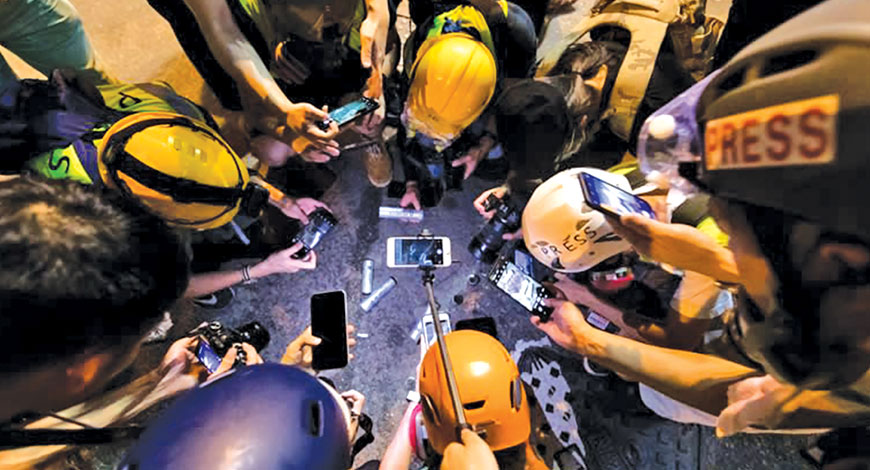
In the weeks ahead of September 29, when a worldwide rally in support of Hong Kong protesters was to be held in 65 cities globally, Shirley’s team worked up to 18 hours a day to promote the event on social media, urging people from different countries to take part.
Shirley and her team have created materials tailored to different platforms. “We invent memes, GIFs and hashtags for Twitter feeds to attract attention. On the other hand, we post more in-depth articles on online forums like Reddit and Quora, where we want to establish meaningful conversations for people around the world to understand the situation in Hong Kong,” she said. “In terms of size, we can never compete with the 50-cent army. But I believe authentic interactions are much more powerful than spam comments.”
While authenticity has proved an effective strategy for the protest groups, egregious fakery has undermined the pro-Beijing campaign.
Since August, social media platforms Twitter and Facebook announced that they had taken down tens of thousands of accounts that they said were connected to state-backed misinformation campaigns.
Fu’s research found that 20 percent of the feeds related to the Hong Kong protests on Twitter have been posted by fake accounts, which display minimal interaction with other users. By contrast, he said, only 10 percent of feeds posting on the 2016 US election, when Russia was accused of using social media to skew the outcome, were fake. “This is a staggering figure,” he said. The actual impact of these fake accounts, he added, is yet to be measured.
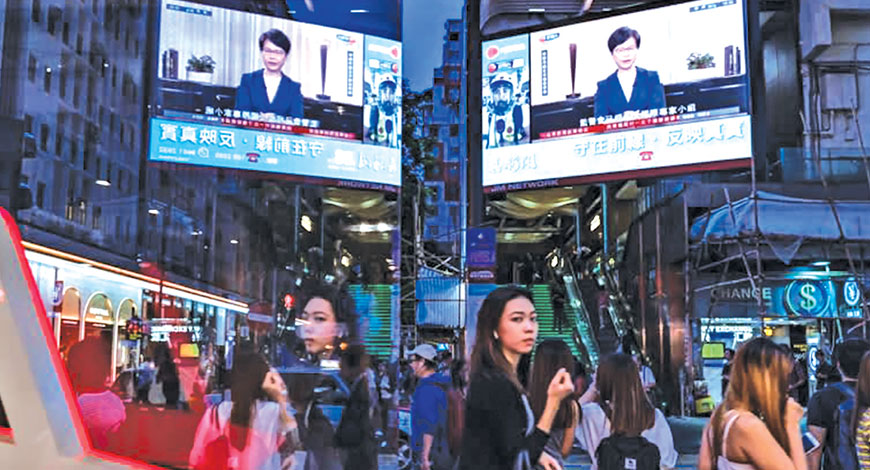
Twitter has since blocked state-run media outlets from advertising on its platform, while YouTube has begun to label videos that are linked to government-funded outlets. In the UK, media regulator Ofcom is investigating the state-backed China Global Television Network for breaching its rules on impartiality.
Over the past few weeks, China’s international campaign to suppress pro-Hong Kong messaging has spilled over into sports, where it has reached a new audience.
On October 4, Daryl Morey, the general manager of the Houston Rockets basketball team, tweeted his support for the Hong Kong protesters, triggering a firestorm of criticism from Beijing. The NBA’s apparent acquiescence to Chinese sensitivities – including the ejection of fans wearing pro-Hong Kong T-shirts from games in the US – has meant that China’s media war itself has been leading the news agenda in America and beyond.
Days later, a professional gamer was suspended by the organizer of an esports tournament after he chanted a pro-Hong Kong slogan during a livestream. The organizer, Blizzard, is based in the US, but apparently feared that a reaction from Beijing would damage its business in China.
These events, Larry Ong said, demonstrate that the Communist Party’s hardline approach to silence oppositions overseas can backfire, as they have attracted worldwide condemnation and earned protesters much sympathy internationally instead.
“It raised greater awareness worldwide about why the Hong Kong people are going to great length to protest,” he said, adding that the miscalculations by Beijing have, in turn, made China’s encroachment on free speech more obvious to the world. “Countries need to deploy counter-influence operations and educate their citizens about the threats of the Chinese Communist Party propaganda before it is too late,” he said. Nikkei Asian Review






You must be logged in to post a comment Login